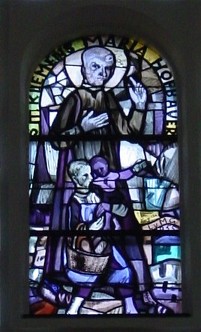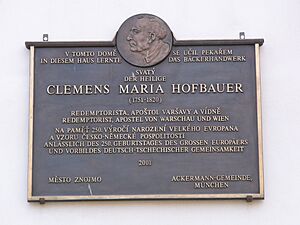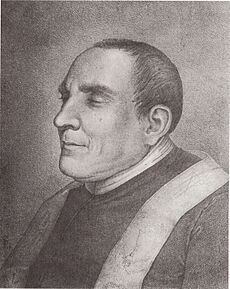Clement Mary Hofbauer facts for kids
Quick facts for kids SaintClement Mary Hofbauer CSsR |
|
|---|---|

Hofbauer's tombstone in the Church of Maria am Gestade, Vienna, Austria
|
|
| Born | Johannes Hofbauer 26 December 1751 Taßwitz, Znojmo District, Margraviate of Moravia, Habsburg Empire |
| Died | 15 March 1820 (aged 68) Vienna, Austrian Empire |
| Venerated in | Roman Catholic Church |
| Beatified | 29 January 1888 by Pope Leo XIII |
| Canonized | 20 May 1909 by Pope Pius X |
| Feast | 15 March |
| Patronage | Vienna, Austria; Dartmouth College |
Clement Mary Hofbauer (26 December 1751 – 15 March 1820) was a Catholic priest from Moravia. He was part of the Redemptorist religious group. He helped start this group in countries north of the Alps mountains, even though it began in Italy. Because of his efforts, he is seen as a co-founder of the Redemptorists in these areas.
Clement Mary Hofbauer was known for helping poor people throughout his life. This was during a difficult time in Europe when many people had lost everything. He worked in Poland until he was forced to leave. Then, he moved to Austria and continued his mission. Today, he is remembered as a saint in the Catholic Church. He is also called the "Apostle of Vienna" and is one of Vienna's patron saints.
Contents
Biography of Clement Mary Hofbauer
Early Life and Dreams
Clement Mary Hofbauer was born Johannes Hofbauer on December 26, 1751. This was in a village called Taßwitz, which is now part of the Czech Republic. He was the ninth of twelve children. His father was a farmer and butcher.
When Johannes was six, his father died. It was very hard for a poor widow's son to become a priest back then. Still, he began studying Latin with the local priest. This showed he might want to become a priest. But his studies stopped when he was fourteen because the priest died.
Becoming a Baker and a Hermit

Since he could no longer study, Johannes became a baker's apprentice in the nearby town of Znojmo in 1767. Later, in 1770, he worked at a bakery in a monastery called Kloster Louka. During this time, there was war and hunger. Many people depended on the monastery for food. Johannes worked very hard to bake bread for everyone.
He stayed at the monastery until 1775. Then, he decided to live as a hermit, a person who lives alone for religious reasons. But after eight years, the emperor of the Habsburg Empire closed all hermitages. So, Johannes moved to Vienna and became a baker again.
In 1782, after a trip to Rome, Clement Mary Hofbauer went to Tivoli, Italy. He tried living as a hermit again at a special church. The local bishop supported him. This is when he took the name Clement Mary. "Clement" was likely after Pope Clement I, and "Mary" was to honor the Virgin Mary. As a hermit, he prayed for everyone, especially those who forgot to pray. He also helped pilgrims visiting the church. But after a few months, he realized he still felt called to become a priest.
He returned to Kloster Louka to bake bread and study Latin again. At 29, two women he met at church helped him. They sponsored him to attend the University of Vienna. At that time, the government controlled universities. This made it hard for students to study for the priesthood. Even though he found some of the teachings difficult, he finished his philosophy studies by 1784. But he couldn't become a priest yet. The emperor had forbidden religious groups from accepting new members.
Joining the Redemptorists
On March 19, 1785, Clement Mary Hofbauer and his friend Hübl joined the Redemptorist group. They made special promises to live simply and obey. Ten days later, they became priests in Italy.
Soon after, their leader asked them to start the Redemptorist group north of the Alps. But Emperor Joseph II would not allow new religious groups in his empire. So, the two priests went to Poland instead. On their journey, another baker named Peter Kunzmann joined them. He became the first non-Italian Redemptorist lay brother.
Helping People Beyond the Alps
Warsaw, Poland
Challenges in Warsaw
When Clement Mary Hofbauer arrived in Warsaw in 1787, Poland was going through a very difficult time. There were many wars and changes. This made life very hard for people. The country was divided up by other powerful nations. This caused a lot of fighting and instability.
Warsaw was a dangerous place. The Redemptorists were in constant danger. Bombs even hit the roof of their church three times but did not explode. Despite all this, Clement Mary Hofbauer and his team continued their work.
Helping the Poor
In February 1787, when they arrived in Warsaw, Clement Mary Hofbauer and his friends had no money. He had given their last coins to beggars. They were given a church called St. Benno's to serve German-speaking people. They were also asked to care for an orphanage and a school for children of craftspeople.
Clement Mary Hofbauer had to beg for money and food to help the people. One story says he went to a pub to ask for donations. A customer spat beer in his face. Clement Mary wiped it off and said, "That was for me. Now, what do you have for my boys?" The men were so surprised and sorry that they gave him all their money.
When he saw a homeless boy, he would bring him to the church, clean him, feed him, and teach him a skill. He also taught them about the Christian way of life. When there were too many boys for the church, he opened a special home called the Child Jesus Refuge. To feed the boys, he often had to beg. Once, he even worked a whole day in a bakery, using his old baking skills, to get bread for his boys.
By 1791, the Redemptorists expanded the children's refuge into a larger school. They also opened a boarding school for girls. Many people helped them, but Clement Mary Hofbauer still had to beg door-to-door for his orphans. When he felt overwhelmed, he would pray, "Lord, help! It's high time..." He was loved by his students and by many smart people in the city. He helped his students with advice, teaching, food, and guidance.
Bringing Back Faith
When the Redemptorists first opened their church, it was empty. People didn't trust foreign priests. Many had also stopped practicing their Catholic faith. Clement Mary Hofbauer and his friends worked hard to bring back the Catholic faith.
As they learned Polish, they started helping more people around their church. They began a "Perpetual Mission," which meant they held a full mission every day of the year. People could hear five sermons a day in German and Polish. They also had many other services, like special Masses, prayers, and confessions available day and night.
By 1793, Clement Mary Hofbauer was in charge of the Redemptorists north of the Alps. He started new Redemptorist centers in Germany and Switzerland.
When fighting reached Warsaw, Clement Mary Hofbauer and his friends asked for peace. This made some people suspicious, and they were called traitors. In 1795, when the Prussians took over Warsaw, they tried to close the school. Clement Mary Hofbauer wrote to the Prussian king. He explained that 256 boys and 187 girls attended the school. It was the only school for girls in Warsaw. The children were poor, and many were homeless orphans who lived at the school for free. But it didn't help, and the school was closed.
Despite these challenges, St. Benno's became a very active center for the Catholic Church in Warsaw. By 1800, the number of people receiving sacraments had grown from 2,000 to over 100,000.
Clement Mary Hofbauer also started training young men to become Redemptorists. He taught them philosophy and theology. By 1803, he had 18 priests, and by 1808, there were 36 Redemptorists.
In 1806, the French took over. A new law stopped the Redemptorists from preaching in other churches. Then, they were even forbidden from preaching and hearing confessions in their own church. In 1808, Napoleon ordered them to be taken to a fortress. They were released after a month but were not allowed to return to Poland.
Work in Vienna

Clement Mary Hofbauer arrived in Vienna in September 1808. He stayed there until he died almost 13 years later. In 1809, when Napoleon's army attacked Vienna, Hofbauer worked as a chaplain in a hospital. He cared for many wounded soldiers. The archbishop saw how dedicated he was and asked him to care for a small Italian church.
In 1813, he became the chaplain for the Ursuline Sisters. He became known as a powerful preacher and a kind confessor.
Vienna was a big cultural center at this time. Clement Mary Hofbauer enjoyed spending time with students and thinkers. He especially cared for young people at the university. He always offered them spiritual and practical help. Students would visit him to talk, share a meal, or get advice. Many of them later became Redemptorists.
A group of educated people in Vienna gathered around Clement Mary Hofbauer. Through them, he helped bring a religious revival to Austria. He guided many famous and artistic people into the Catholic Church.
Later, Clement Mary Hofbauer faced challenges again. For a short time, he was not allowed to preach. He was even threatened with being sent away from Austria. But the emperor of Austria, Franz, was on a trip to Rome and met the Pope. The Pope told the emperor how much Clement Mary Hofbauer's work was valued. The Pope encouraged the emperor to allow the Redemptorists to start a group in Austria.
Instead of being sent away, Clement Mary Hofbauer was invited to meet Emperor Franz. A church was chosen to become the first Redemptorist center in Austria. However, Clement Mary Hofbauer became ill in early March 1820 and died on March 15. His funeral was a very big event in Vienna.
In 1862, Clement Mary Hofbauer's remains were moved to the Redemptorist church in Vienna.
Becoming a Saint
In 1888, Pope Leo XIII began the process to make Clement Mary Hofbauer a saint. He was first declared "blessed." Then, 21 years later, in 1909, Pope Pius X officially recognized him as a saint.
The Polish bishops also recognized Clement Mary Hofbauer as a Polish saint because of his important work in Warsaw. He is a patron saint of bakers and waiters, and one of the patron saints of Warsaw.
In art, Clement Mary Hofbauer is shown wearing the Redemptorist clothes. His symbol is the cross. His feast day is celebrated on March 15.
After he became a saint, churches were named after him. One was in New York City, serving the Polish community. Another was in Berlin, Germany. Clement Mary Hofbauer is also the patron saint of Dartmouth College in the United States.
Legacy
Clement Mary Hofbauer is one of the people shown in Jan Matejko's famous 1891 painting, Constitution of 3 May 1791.
Gallery
See also
 In Spanish: Clemente María Hofbauer para niños
In Spanish: Clemente María Hofbauer para niños







